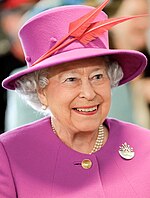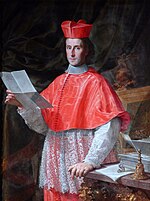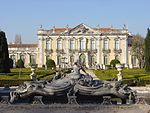Featured article 1
Portal:Monarchy/Featured article/1
The Prince's Palace of Monaco is the official residence of the Prince of Monaco. Originally founded in 1191 as a Genoese fortress, during its long and often dramatic history it has been bombarded and besieged by many foreign powers. Since the end of the 13th century, it has been the stronghold and home of the Grimaldi family who first captured it in 1297. The Grimaldis' power was often derived from fragile agreements with their larger and stronger neighbours. Thus while the sovereigns of Europe were building luxurious, modern Renaissance and Baroque palaces, politics and common sense demanded that the palace of the Monaco rulers be fortified. The Grimaldis' occupation of their palace is also unusual because, unlike other European ruling families, the absence of alternative palaces and land shortages have resulted in their use of the same residence for more than seven centuries. During the 19th and early 20th centuries, the palace and its owners became symbols of the slightly risqué glamour and decadence that was associated with Monte Carlo and the French Riviera. Glamour and theatricality became reality when the American film star Grace Kelly became chatelaine to the palace in 1956. In the 21st century, the palace remains the residence of the current Prince of Monaco.
Featured article 2
Portal:Monarchy/Featured article/2
The monarchy of the United Kingdom is the constitutional monarchy of the United Kingdom, its dependencies and its overseas territories. The current monarch and head of state, Queen Elizabeth II, ascended the throne on the death of her father, King George VI, on 6 February 1952. The monarch and his or her immediate family undertake various official, ceremonial, diplomatic and representational duties. As the monarchy is constitutional, the monarch is limited to non-partisan functions such as bestowing honours and appointing the Prime Minister. The monarch is commander-in-chief of the British Armed Forces. Though the ultimate formal executive authority over the government of the United Kingdom is still by and through the monarch's royal prerogative, these powers may only be used according to laws enacted in Parliament and, in practice, within the constraints of convention and precedent.The British monarchy traces its origins from the petty kingdoms of early medieval Scotland and Anglo-Saxon England, which consolidated into the kingdoms of England and Scotland by the 10th century AD. In 1066, the last crowned Anglo-Saxon monarch, Harold Godwinson, was defeated and killed during the Norman conquest of England and the English monarchy passed to the Normans' victorious leader, William the Conqueror, and his descendants.
Featured article 3
Portal:Monarchy/Featured article/3
The House of Gediminas were the siblings, children, and grandchildren of Gediminas, Grand Duke of Lithuania (ca. 1275–1341). The Gediminid dynasty ruled the Grand Duchy of Lithuania from ca. 1285 or 1316 to 1572, eventually extending its territories from the Baltic Sea to the Black Sea. Gediminas' origins are unclear, but recent research suggests that Skalmantas, an otherwise unknown historical figure, was Gediminas' grandfather or father, and could be considered the dynasty's founder. Because none of his brothers or sisters had known heirs, Gediminas, who sired at least twelve children, had the advantage in establishing sovereignty over his siblings. Known for his diplomatic skills, Gediminas arranged his children's marriages to suit the goals of his foreign policy: his sons consolidated Lithuanian power within the Grand Duchy of Lithuania, while his daughters established or strengthened alliances with the rulers of areas in modern-day Russia, Ukraine, and Poland. Gediminas' many grandchildren and their descendants engaged in power struggles that continued well into the 15th century. Gediminas' grandchildren converted Lithuania to Christianity and inaugurated the first personal union with Poland. The dynasty came to an end in 1572, when Sigismund II Augustus died without producing a male heir.
Featured article 4
Portal:Monarchy/Featured article/4
Royal Maundy is a religious service in the Church of England held on Maundy Thursday, the day before Good Friday. At the service, the British Monarch or a royal official ceremoniously distributes small silver coins known as "Maundy money" as symbolic alms to elderly recipients. The name "Maundy" and the ceremony itself derive from an instruction, or mandatum, of Jesus at the Last Supper that his followers should love one another. In the Middle Ages, English monarchs washed the feet of beggars in imitation of Jesus, and presented gifts and money to the poor. Over time, additional money was substituted for the clothing and other items that had once been distributed; the custom of washing the feet did not survive the 18th century. Today, Queen Elizabeth II (pictured at the 2005 service) almost always attends, and the service is held in a different church (usually a cathedral) every year. Maundy money is struck in denominations of one penny, two pence, three pence, and four pence. In most years there are fewer than 2,000 complete sets; they are highly sought after by collectors.
Featured article 5
Portal:Monarchy/Featured article/5
The 1881 world tour of King Kalākaua of the Kingdom of Hawaii was his attempt to save the Hawaiian culture and population from extinction by importing a labor force from Asia-Pacific nations. His efforts brought the small island nation to the attention of world leaders, but sparked rumors that the kingdom was for sale. Critics in Hawaii believed the labor negotiations were just an excuse to see the world. The 281-day trip gave Kalākaua the distinction of being the first monarch to circumnavigate the globe; his 1874 travels had made him the first reigning monarch to visit America and the first honoree of a state dinner at the White House.Kalākaua met with heads of state in Asia, the Mideast and Europe, to encourage an influx of sugar plantation labor in family groups, as well as unmarried women as potential brides for Hawaii's existing contract laborers. While in Asia, he tried to forestall American ambitions by offering a plan to Emperor Meiji for putting Hawaii under the protection of the Empire of Japan with an arranged marriage between his niece Kaʻiulani and a Japanese prince. On his visit to Portugal, he negotiated a treaty of friendship and commerce with Hawaii that would provide a legal framework for the emigration of Portuguese laborers to Hawaii. The King had an audience in Rome with Pope Leo XIII and met with many of the crowned heads of Europe. Britain's Queen Victoria and the splendor of her royal life impressed him more than any other monarchy; having been greatly affected by the ornate trappings of European sovereigns, he would soon have Hawaii's monarchy mirror that grandeur.
Featured article 6
Portal:Monarchy/Featured article/6
he House of Plantagenet (1154–1485) was the royal house of all the English kings from Henry II to Richard III, including the Angevin kings and the houses of Lancaster and York. In addition to the traditional judicial, feudal and military roles of the king, the Plantagenets had duties to the realm that were underpinned by a sophisticated justice system. They were often forced to agree to constraints on royal power, such as Magna Carta, in return for financial and military support. During their reigns, a distinct national identity was shaped by conflict with the French, Scots, Welsh and Irish, and by the establishment of English as the primary language. In the 15th century, the Plantagenets were defeated in France in the Hundred Years' War and beset with social, political and economic problems. Revolts were triggered by politics and by the denial of freedoms. English nobles raised private armies, engaged in private feuds and openly defied Henry VI. Rivalry between the Yorkists and Lancastrians erupted into the Wars of the Roses. After Richard III's death ended the reign of the Plantagenets, Henry VII founded the Tudor dynasty.
Featured article 7
Portal:Monarchy/Featured article/7
A cardinal-nephew is a cardinal elevated by a pope who is his uncle, or more generally, his relative. The practice of creating cardinal-nephews originated in the Middle Ages, and reached its apex during the 16th and 17th centuries, and is central to the etymology of the word nepotism, which appeared in the English language circa 1670. From the middle of the Avignon Papacy (1309–1377) until Pope Innocent XII's anti-nepotism bull, Romanum decet pontificem (1692), a pope without a cardinal-nephew was the exception to the rule. Every Renaissance pope who created cardinals appointed a relative to the College of Cardinals, and the nephew was the most common choice. The institution of the cardinal-nephew evolved over seven centuries, tracking developments in the history of the Papacy and the styles of individual popes. From 1566 until 1692, a cardinal-nephew held the curial office of the "Superintendent of the Ecclesiastical State". The curial office as well as the institution of the cardinal-nephew declined as the power of the Cardinal Secretary of State increased and the temporal power of popes decreased in the 17th and 18th centuries. Notable cardinal-nephews include fourteen popes—John XIX, Benedict IX, Anastasius IV, Gregory IX, Alexander IV, Adrian V, Gregory XI, Boniface IX, Eugene IV, Paul II, Alexander VI, Pius III, Julius II, and Clement VII—and two saints—Charles Borromeo and Anselm of Lucca.
Featured article 8
Portal:Monarchy/Featured article/8
Chinese society during the Song Dynasty was marked by political and legal reforms, a philosophical revival of Confucianism, and the development of cities beyond administrative purposes into centers of trade, industry, and maritime commerce. The inhabitants of rural areas were mostly farmers, although some were also hunters, fishers, or government employees working in mines or the salt marshes. Contrarily, shopkeepers, artisans, city guards, entertainers, laborers, and wealthy merchants lived in the county and provincial centers along with the Chinese gentry—a small, elite community of educated scholars and scholar-officials. The military also provided a means for advancement in Song society for those who became officers, even though soldiers were not highly-respected members of society. Although certain domestic and familial duties were expected of women in Song society, they nonetheless enjoyed a wide range of social and legal rights in an otherwise patriarchal society. Women's improved rights to property came gradually with the increasing value of dowries offered by brides' families. Daoism and Buddhism were the dominant religions of China in the Song era, the latter deeply impacting many beliefs and principles of Neo-Confucianism throughout the dynasty. The Song justice system was maintained by policing sheriffs, investigators, official coroners, and exam-drafted officials who acted as magistrates.
Featured article 9
Portal:Monarchy/Featured article/9
Pope Paul III and His Grandsons is an oil on canvas painting by Titian, housed in the Museo di Capodimonte, Naples. It was commissioned by the Farnese family and painted during Titian's visit to Rome between autumn 1545 and June 1546. It depicts the thorny relationship between Pope Paul III, born Alessandro Farnese, and two of his grandsons, Ottavio and Alessandro. The painting explores the effects of ageing and the manoeuvring behind succession; Paul was at the time in his late seventies and operating within an uncertain political climate as Charles V came into ascendancy. Paul was not a religious man; he viewed the papacy as a means to consolidate his family's position. He appointed Alessandro as cardinal against accusations of nepotism, fathered a number of illegitimate children and spent large sums of church money collecting art. Titian abandoned the commission before completion, and for the next 100 years the painting languished unframed in a Farnese cellar. It ranks as one of Titian's most penetrating works. The panel contains subtle indications of the contradictions in the character of the Pope, and captures the complex psychological dynamic between the three men.
Featured article 10
Portal:Monarchy/Featured article/10
The Queluz National Palace is a Portuguese 18th-century palace located at Queluz, a freguesia of the modern-day Sintra municipality, in the District of Lisbon. One of the last great Rococo buildings to be designed in Europe, the palace was conceived as a summer retreat for Dom Pedro of Braganza, who was later to become husband and then king consort to his own niece, Queen Maria I. It served as a discreet place of incarceration for Queen Maria as her descent into madness continued in the years following Dom Pedro's death in 1786. Following the destruction by fire of the Ajuda Palace in 1794, Queluz Palace became the official residence of the Portuguese prince regent, John VI, and his family and remained so until the Royal Family fled to Brazil in 1807 following the French invasion of Portugal. Work on the palace began in 1747 under the architect Mateus Vicente de Oliveira. Despite being far smaller, the palace is often referred to as the Portuguese Versailles. From 1826, the palace slowly fell from favour with the Portuguese sovereigns. In 1908, it became the property of the state. Following a serious fire in 1934, which gutted the interior, the palace was extensively restored, and today is open to the public as a major tourist attraction.
Featured article 11
Featured article 12
Featured article 13
Featured article 14
Featured article 15
Usage
The layout design for these subpages is at Portal:Monarchy/Featured article/Layout.
- Add a new Featured article to the next available subpage.
- Update "max=" to new total for its {{Random portal component}} on the main page.
Additions
Feel free to add royalty related articles Featured articles to the above list.








